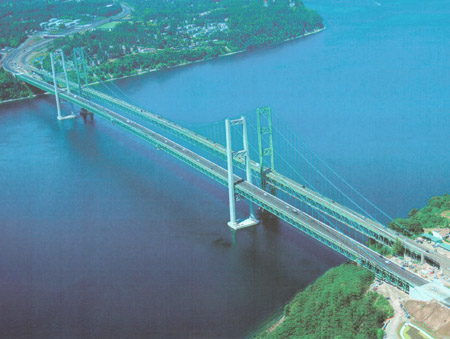
 |
|
Public Works Bridges |

Photo courtesy of WSDOT The two towers in the new Tacoma Narrows Bridge, left, are made of concrete instead of steel like the existing bridge.
New Tacoma Narrows Bridge |
|
Location: Tacoma
|
|
The new Tacoma Narrows Bridge took about 4.5 years to build and opened in July of 2007. The project consisted of 2.5 miles of widened roadway on both sides of the Tacoma Narrows and a 5,400-foot-long suspension bridge over the water. Included are four eastbound lanes across the new bridge and four westbound lanes across the 1950s bridge. Major bridge components built with reinforced concrete included the anchorages, caissons and towers. The anchorages secure the new bridge’s suspension cables at each side of the narrows. Each is embedded 60 feet below ground and contains 20,000 cubic yards of concrete. A special low-slump mix made with flyash and low cement allowed concrete to be placed by conveyor and reduced heat generation. Crews poured 2,800 cubic yards of the mix in one day. The concrete supplier set up a temporary batch plant on the Gig Harbor side to deliver concrete to the in-water caissons and towers. Two 500-horsepower pumps at each end of the bridge were used to move the concrete through two slicklines on a temporary catwalk. Concrete was delivered by truck to the pumps, which then moved the mix 1,300 feet along the catwalk, down the tower and across a temporary bridge to the two new caissons. Each caisson is made of 41,000 cubic yards of concrete and measures 80-by-130 feet. The caisson on the Tacoma side is located under 150 feet of water and the caisson on the other side is under 135 feet of water. Both are embedded 67 feet into the narrows floor. Caissons were built atop the water surface in currents that sometimes reached 7.5 knots. During construction, each 10-foot lift of concrete lowered the entire caisson 9 feet in the water. Each of the bridge’s twin 510-foot-tall towers required 8,500 cubic yards of concrete. Crews used a self-climbing form system that allowed construction of 17.5 feet of tower in each lift. Concrete was delivered in a 5-cubic-yard bucket attached to a tower crane. The bridge reportedly was the state’s first mega-project to use the design-build delivery process — and the first worldwide design-build project for a major suspension bridge.
|
|
Copyright ©2008
Seattle Daily Journal and DJC.COM. Comments? Questions? Contact us. |